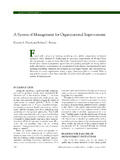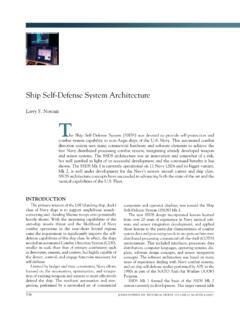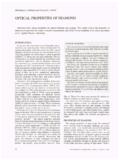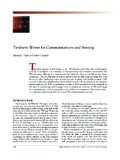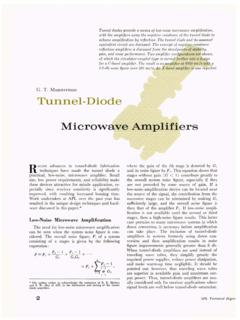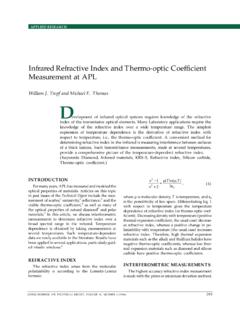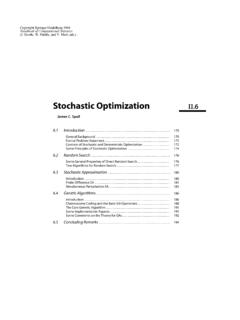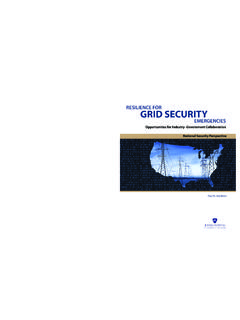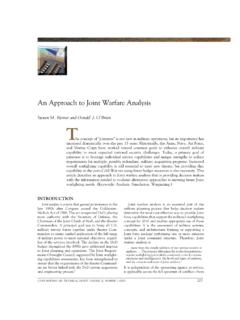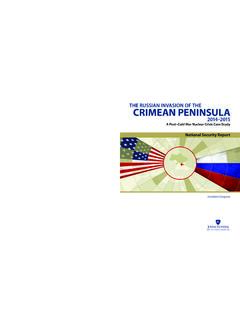Transcription of A Materials Aging Problem in Theory and Practice
1 JOHNS HOPKINS APL TECHNICAL DIGEST, VOLUME 21,NUMBER 4 (2000)575A Materials Aging PROBELM IN Theory AND PRACTICEPA Materials Aging Problem in Theory and PracticeLawrence W. Hunter, James W. White, Paul H. Cohen, and Paul J. Biermannolyesters are widely used in plastic objects, films, and fabrics. A recurringmechanism of polyester Aging is attack by humidity (hydrolysis), whereby the longchain molecules are cleaved and the material softens. This article offers an approach formodeling the hardness/ Aging behavior of commercial polyesters. The model isqualitatively consistent with exposure tests on fresh polyester plastic material madefrom a commercially available resin and hardening agent. It expresses the rate ofpolyester hydrolysis in terms of the relative humidity, and then connects the degree ofhydrolysis to hardness using a relation that accounts for stabilizers that are present incommercial polymers to counter the hydrolysis.
2 (Keywords: Balance of life, Environ-mental exposure, Ester hydrolysis, Materials Aging , Polyester hydrolysis, Polyesters.)INTRODUCTIONAny model that predicts when a material will breakdown, reach the end of its service life, or stop perform-ing as required offers many benefits. With safety andperformance assured, it becomes possible to achieve themaximum service life and the most economical sched-ule for disposals and upgrades. In Practice , the price canbe continuous monitoring of environmental exposureconditions like temperature, humidity, shocks, andvibrations. In addition, model accuracy is impacted bythe complexities of commercial article offers a model of the hardness/ Aging ofcommercial polyester Materials exposed to heat andhumidity. Polyester Materials have a wide range ofapplications including filter wool, photographic filmbases, packaging films, magnetic media, textiles, softdrink bottles, furniture parts, and numerous other plas-tic entanglements that occur between long molec-ular chains give a polymer its hardness.
3 However, themolecular chains in polyesters have weak links, namely,the ester links, which can be cleaved by chemical re-action with water as follows:COO+ H2O =COHO+ HOThe first member of this equation is the weak esterlink. The chemical bonds shown as dashed lines con-nect to the remaining parts of the polymer. These partsbecome disconnected, and hence the polymer chainsbecome less entangled. The material tends to soften asa result. After the reaction, the two loose ends termi-nate, as shown on the right side of the equation, as a carboxylic acid group and an alcohol literature on ester chemistry1,2 shows that thecleavage reaction is promoted ( catalyzed ) by a traceof acidity in the water. For example, the reaction goesAPPLIED RESEARCHL. W. HUNTER ET HOPKINS APL TECHNICAL DIGEST, VOLUME 21, NUMBER 4 (2000)much faster with a trace of hydrochloric acid (HCl) inthe water.
4 Interestingly, one of the loose ends createdis itself acidic, , the carboxylic acid group, as itsname indicates. Thus, the reaction promotes itself onceit starts (the reaction is autocatalytic ).The preceding chemical equation is a simplificationof the sequence of molecular collisions that actuallyoccur to achieve the same net result. We will examinethe more detailed description later in the article. Mean-while, we begin with the one-step reaction as given,since it turns out that this provides a very good TESTSWe made fresh commercial-grade polyester materialby combining a resin with a curing (hardening) agentin a mold and then applying heat. Air Products andChemicals, Inc., supplied the ingredients: Voranol 630(a trifunctional polyol) and Versathane A-8 (a toluenediisocyanate polyester prepolymer).
5 With this newmaterial, we were able to reset our clocks back to time0 and maintain control over the complete history ofenvironmental fresh samples were exposed to 100% relativehumidity (RH) at three temperatures (Fig. 1). Resultsshowed that higher temperatures promoted temperature effect was consistent with the hypoth-esis that the softening is caused by a chemical reactionwith water, since the rates of chemical reactions typ-ically increase as temperature data points in Fig. 1 show some fluctuations dueto experimental precision and reproducibility. It be-comes a matter of judgment to identify underlyingtrends that reflect the chemistry. Our interpretation isthat hardness tends to remain initially constant andthat the time of constant hardness decreases as temper-ature rises; then hardness starts to fall at a rate thatincreases as temperature increases; and finally, thesoftening tends to accelerate slightly with time.
6 Similarqualitative trends have been reported in the MODEL OF AGINGThe next step is to extrapolate the results to am-bient temperatures. Our preliminary model of thetemperature dependence evolved from a simple pic-ture of the chemical reactions, since simple models arebest, if they work. Commercial polyesters like ourscontain an additive called a stabilizer that reconnectsbroken ester links until the stabilizer is depleted(Wirpsza3 lists three classes of stabilizers, including carbodiimides whose structure and mechanism ofaction were explained by Shoffenberger and ) Hence, retention of hardness depends on theamount of stabilizer present. The initial rate of reac-tion between unstabilized ester links and water atvarious temperatures was measured by Brown et results were combined with an ad hoc model ofhardness in terms of the number of ester links and theamount of stabilizer.
7 The result is a preliminary modelof hardness versus temperature and humidity for com-mercial (stabilized) concentration of ester links in an unstabilizedpolyester decreases with time according to5 = 0e kRHt,in which 0 is the concentration at time 0, k is the rateconstant, and t is time. All of the temperature depen-dence is concentrated in k, which has the Arrhenius formk = Ae E/RT,where R = 10 3 kcal mol 1 K 1. The frequencyfactor A and activation energy E were adjusted tofit our data:A = 1014 day 1andE = kcal mol a footnote, the values of A and E would be differentif we had chosen to write the concentration of ester linksin terms of the partial pressure of water vapor rather thanthe relative humidity, but the form of the equationswould be identical. All of the dependence on temper-ature would still be isolated explicitly in an Arrheniusexponential factor whose pre-exponential coefficientand activation energy are independent of turns out that our activation energy E, for example,is actually the activation energy forester hydrolysis minusthe activation energy for water (shore A)010203040506070 Exposure time (days)120 F140 F160 FFigure 1.
8 Tests of fresh material in 100% relative humidity exposedto three different HOPKINS APL TECHNICAL DIGEST, VOLUME 21, NUMBER 4 (2000)577A Materials Aging PROBELM IN Theory AND PRACTICEThis rate law implies that, as soon as the materialis exposed to humidity, the ester links begin to is assumed to be tied to the sum of the esterlinks and the replacement links created by the stabi-lizer. This sum remains constant even though the num-ber of actual ester links is declining, as long as astabilizer is present. After the stabilizer supply has beenexhausted, the sum starts to decline with the ester links,one for one. Hence, the relationship between (nondi-mensional) hardness and the (nondimensional) con-centration of ester links is assumed to be like thatshown in Fig. 2. For the best fit to our data, we assumedthat a fraction s = of the ester links can be sta-bilized.
9 Specifically, hardness is assumed to be propor-tional to the concentration of ester links after a fractions = has been hydrolyzed. Surely, the true relationbetween hardness and links is much more , it is interesting to pursue this approach to see whatqualitative conclusions may be results, for comparison with the measurements,are shown in Fig. 3. Clearly, the predicted curve at160 F is less severe than the observations. Less dramaticbut still evident is the tendency of the predicted curvesto level out with time, whereas the observations showa slight tendency to accelerate downward. In addition,the predictions say nothing about acidity. In fact, acidautocatalysis is a potential cause of the acceleration.(Another mechanism contributing to the accelerationmay be the expected increase in water absorption asbonds begin to break and porosity increases.)
10 Still, overall, the model is quite successful. Despite itssimplicity, many of the qualitative features of the dataare captured, including the presence of a delay time thatdecreases as temperature rises, as well as the tendency ofthe downward rate to increase as temperature TO CONDITIONSIN THE FIELDOur laboratory tests accelerated the Aging of thesamples through the use of elevated temperatures. Thereasonableness of the model under test conditions sug-gests using it to extrapolate to conditions more likethose expected in the field, where temperature andhumidity vary depending on the time of day, the localclimate, and the seasons. What is needed is a procedureto estimate the cumulative effects, including the effectsof temporary excursions to high temperature and hu-midity.
